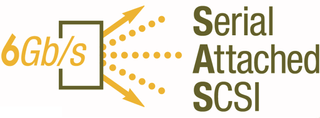Next-Generation SAS: 6 Gb/s Storage Hits The Enterprise

SAS Moves On: 6 Gb/s Available Now
For years, Serial Attached SCSI (SAS) has been gradually replacing the aging Small Computer System Interface (SCSI) in the business and enterprise storage segments. While SCSI was a parallel bus technology with many limitations, SAS is characterized as a serial interconnect architecture, allowing businesses to manage complex storage solutions in a very scalable and flexible fashion. Second-generation SAS now makes the architecture even better, starting by doubling the link speed from 3 Gb/s to 6 Gb/s.

Why SAS?
Serial Attached SCSI is not just a serial implementation of the SCSI protocol. There’s more to it than simply carrying forward SCSI features, such as TCQ (Tagged Command Queuing), across a new connector. If simplicity were the name of the game in storage, we’d all be using Serial ATA (SATA), which employs a basic point-to-point connection between a host and an end device, such as a hard drive.
However, SAS is based on an object model that defines a “SAS domain,” a delivery subsystem that includes optional expanders and SAS end devices, such as hard drives and host bus adapters (HBAs). Unlike SATA, SAS devices may have multiple ports, each of which can utilize multiple physical connections to enable faster (wider) SAS links. In addition, multiple initiators may access any given target, and cable length can be up to eight meters (for the first generation of SAS) instead of SATA’s one meter. Obviously, this enables a plethora of options for creating redundant or high-performance storage solutions. In addition, SAS implements SATA Tunneling Protocol (STP), allowing you to run SATA drives from a SAS controller.
SAS 2.0
Second-gen SAS is supposed to speed up connections from 3 to 6 Gb/s. This speed boost is very important in complex environments, where applications require high-bandwidth links to high-performance storage appliances. The new SAS version also aims at reducing the complexity of cabling and the number of connections per Gb/s of bandwidth by increasing available cable length and improving expander zoning/self-discovery. We’ll talk about these changes in detail.
Ramping Up 6 Gb/s SAS
Stay On the Cutting Edge: Get the Tom's Hardware Newsletter
Get Tom's Hardware's best news and in-depth reviews, straight to your inbox.
In an effort to promote the benefits of SAS to a broad audience, the SCSI Trade Association (SCSI TA) presented a turorial on SAS technology at the Storage Networking World Conference earlier this year in Orlando, FL. A so-called SAS Plugfest, which demonstrated SAS 6 Gb/s interoperability, compatibility, and functionality, had preceded in November of 2008. LSI and Seagate are the first to market with SAS 6 Gb/s-compatible hardware, but others will follow soon. This article provides an overview on the state of the SAS union and introduces some of the first devices. For more on what we've seen SAS 6 Gb/s do already performance-wise, check out our efforts to break a storage throughput record with the technology.
Most Popular



